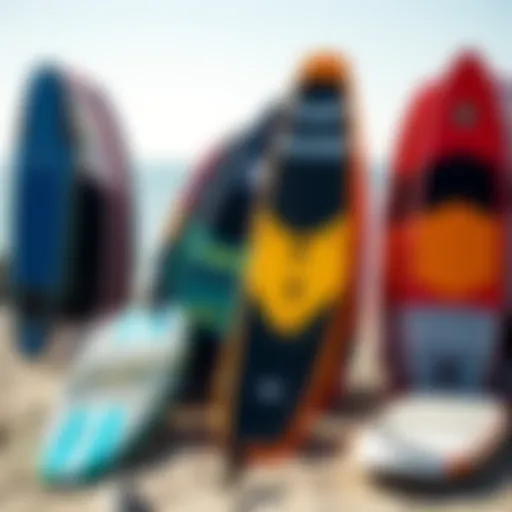The Importance of Safety Leashes in Kitesurfing
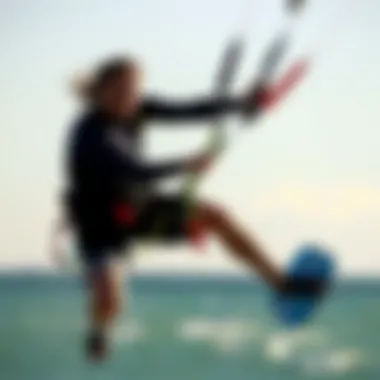
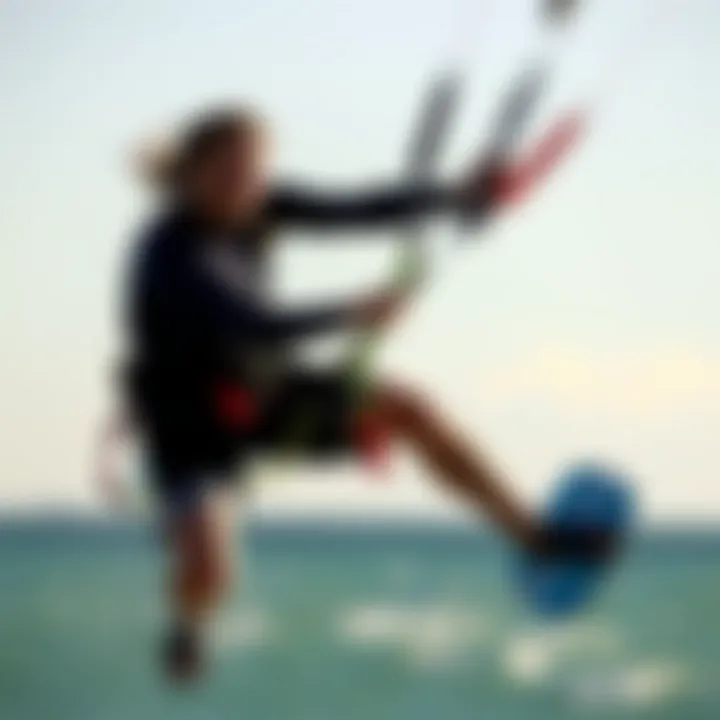
Intro
Kitesurfing is a thrilling blend of surfing, wind and aerial acrobatics. As exhilarating as it is, it also comes with risks that can turn a joyride into a dangerous affair. One of the most critical pieces of safety equipment is the safety leash. It keeps the rider tethered to their kite, ensuring that even if you wipe out, you're not going to lose your kite to the wind and the waves.
This article pulls back the curtain on safety leashes, shedding light on their various types, functions, and the essential role they play in securing your safety every time you hit the water. With information grounded in industry standards and practical experiences, this guide will travel through the intricacies of this crucial piece of gear, providing insights for both newcomers and seasoned kitesurfers alike.
The Importance of Safety in Kitesurfing
Kitesurfing is an exhilarating sport that lets enthusiasts ride the wind and waves, but it doesn't come without its risks. The decision to partake in this demanding activity demands an understanding of safety, as the potential for accidents is ever-present. Riders face various hazards ranging from equipment failure to changing weather conditions, and unexpected maneuvers can dramatically elevate these risks. With safety at the forefront, ensuring that all necessary precautions and gear are in place becomes a non-negotiable priority for anyone hitting the water.
Overview of Kitesurfing Risks
Understandably, the excitement of kitesurfing attracts many adventurers; however, a thorough evaluation of the risks involved is essential. Common risks include:
- Equipment Failure: Kites, lines, and harnesses need to be in prime condition. Even a minor malfunction can lead to disastrous outcomes, often leaving riders at the mercy of the elements.
- Weather Changes: Rapid shifts in wind speed or direction can create perilous situations, leaving riders struggling to maintain control.
- Collisions: Riders are often surrounded by others. Colliding with another kitesurfer or a stationary object like a boat can lead to injury for both parties involved.
Knowing these risks can help one prepare, because in kitesurfing, knowledge is power. Keeping an ear to the ground about weather shifts or observing fellow riders can contribute to a safer session.
Why Safety Gear Matters
The importance of safety gear, particularly safety leashes, can't be overstated. When the unexpected manifests, the right gear can be the difference between a close call and a serious incident. Safety gear, including helmets, impact vests, and most crucially, safety leashes, serve to provide much-needed safety. These items act as lifelines, securing riders to their kites and providing means for quick release in emergencies.
- Preventing Equipment Loss: A safety leash ensures that if a rider loses control, their kite won’t simply drift away, potentially endangering others.
- Emergency Control: Quick-release systems allow riders to disconnect from their equipment immediately to prevent injury.
- Rider Confidence: When kitesurfers know that they are equipped with reliable safety gear, they can focus more on enjoying the experience rather than worrying about what could go wrong.
"An ounce of prevention is worth a pound of cure," rings true in kitesurfing—on the waves, a proactive approach to safety gear ensures a much more enjoyable session and, most importantly, a safer riding environment.
Ultimately, safety in kitesurfing is an ongoing commitment. With the right understanding and tools, riders can enjoy this thrilling sport while minimizing risks, ensuring that every trip to the water is not just exciting but safe.
What is a Safety Leash?
In the intricate world of kitesurfing, where the thrill of riding the waves and harnessing the power of the wind come with high stakes, the importance of a safety leash cannot be overstated. A safety leash is more than just an accessory; it is a pivotal piece of equipment that ensures the safety of the rider. It connects the rider to the kite, allowing for planned detachment while still offering critical control over the kite’s movements.
Defining the Safety Leash
So, what exactly is a safety leash? At its core, a safety leash is a cord or strap that links a kitesurfer’s harness to the kite’s control system. Think of it as a lifeline, keeping the rider tethered while providing the flexibility needed for maneuverability. A safety leash serves to prevent the kite from drifting away uncontrollably, minimizing potential dangers not just for the rider, but also for those nearby. The design and function of safety leashes are aimed at offering an additional layer of security in a sport that inherently works with unpredictable forces.
The concept of a safety leash can seem straightforward, yet its application has a multitude of facets. First and foremost, it acts as a fail-safe mechanism. If the rider falls or lets go of the control bar, the leash should ideally function to keep the kite from bolting off into the horizon, which may lead to havoc or accidents. In storms or sudden gusts, a well-designed leash may prevent significant entanglements with both the rider and the craft.
Components of a Safety Leash
Understanding the anatomy of a safety leash can significantly impact a rider's experience on the water. The components of a safety leash typically include:
- The Main Line: This is the principal length of cord, usually made from high-strength materials such as Kevlar or nylon, designed to withstand substantial forces during rides.
- Attachment Clip: A secure clip or carabiner attaches the leash to the rider's harness and is engineered to withstand sudden pulls. This clip is essential for quick release during emergencies.
- Quick Release Mechanism: This innovation allows the rider to detach from the kite rapidly, and it is often activated by pulling a trigger mechanism. Efficiency in this component can mean the difference between safety and catastrophe when dealing with unexpected incidents.
- Swivel: Found in some designs, the swivel allows the leash to rotate without tangling, which can be a game changer when navigating tricky waters.
- Padding or Covers: These components can add a layer of cushioning where the leash connects to the rider to prevent chafing during prolonged sessions.
Proper understanding and utilization of these components can not only enhance performance but also elevate safety levels during rides, making it imperative for every kitesurfer to be well-versed with their leash.
"A safety leash is not just an extra strap, it’s a crucial connection that ensures that when something goes wrong, you're not left out to sea."
The gear you choose can profoundly affect your kitesurfing experience, and it’s crucial to consider what type of safety leash suits your needs best. Engaging in discussions with experienced kiteboarders and consulting resources like Wikipedia can provide deeper insights into this often-overlooked piece of equipment.
Types of Safety Leashes
Kitesurfing is undoubtedly thrilling, but it carries certain risks that every rider must be cognizant of. The safety leash is an integral part of a kitesurfer's gear, acting as a line between safety and potential peril. Understanding the various types of safety leashes can enable riders to make informed decisions tailored to their style and the specific conditions they may encounter on the water.
The different types of safety leashes each serve distinct purposes, addressing diverse needs shaped by riding style, equipment, and even environmental factors. Let's delve deeper into these categories and how they can make or break your experience on the waves.
Standard Safety Leashes
Standard safety leashes are the bread and butter of kitesurfing safety gear. Generally designed to provide a basic level of protection, they attach securely to the rider's harness and the kite's control system. The key benefit here is straightforward: if the rider loses grip or control of the kite, the leash prevents it from being completely unattached. This gives a quick remedy to potentially dangerous situations, allowing the rider to focus on regaining control.
However, it's crucial to note that while they serve their primary purpose effectively, standard safety leashes may come with limitations. For instance, if you’re riding in a crowded area or during strong winds, these leashes might not alleviate all the risks associated with entanglement or chaotic movements. So, riders often need to assess their environment carefully. Picking a standard safety leash doesn't mean you're settling for less; rather, it’s about finding a reliable option that feels right for your kiteboarding journey.
Swivel Safety Leashes
Swivel safety leashes take the concept of a standard safety leash a step further by incorporating a rotational mechanism that allows for fluid movement without tangling. If you've ever felt the hassle of a leash twisting around itself like a pretzel mid-ride, you can appreciate this innovation. These leashes ensure that as the rider maneuvers and performs tricks, the connection between the harness and kite remains stable without twisting.
Particularly for freestyle enthusiasts who often engage in rapid rotations or complex aerial maneuvers, the swivel safety leash becomes almost essential. This option provides riders with a wider degree of freedom without the constant worry of getting wrapped up in their own equipment. Remember, fluidity is key when you're pushing your limits, and swivel safety leashes support that need seamlessly.
Emergency Quick Release Leashes
Emergency quick release leashes represent the pinnacle of safety when it comes to kitesurfing gear. This type of leash is designed for those critical moments when a rider finds themselves in a dire situation, whether from a sudden gust of wind or a collision with another surfer. The ability to detach your kite almost instantaneously can be the difference between a minor scare and a severe accident.
The mechanism for releasing typically involves a handle or a pin that can be activated swiftly, often using one hand. However, familiarity with the release process is paramount. In the heat of the moment, confusion can occur, making it crucial for the rider to practice the release multiple times before hitting the waves.
This type of leash is particularly recommended for those riding in challenging conditions; it’s all about being prepared for unforeseen changes in the environment. So don’t just attach it and forget it—take the time to understand how it works. Safety can be a bit of a dance, and knowing your steps can keep you from tripping.
Ultimately, choosing the appropriate safety leash boils down to understanding your individual needs and the demands of your riding style. By diving into the specifics of each type, you can confidently invest in the gear that not only enhances your performance but keeps you safe while doing so.
How Safety Leashes Function
Understanding how safety leashes work is crucial for anyone serious about kitesurfing. These devices are not just accessories; they are life-saving tools designed to ensure that a rider has control over their kite at all times. Safety leashes typically join the rider’s harness to the kite’s control system, allowing for a quick response during unforeseen situations, such as gusty winds or sudden crashes. When riders are informed about how these components operate together, they can make more confident decisions on the water, making safety a priority.
Attachment Mechanisms
The attachment mechanism of a safety leash is the very keystone of its functionality. This component typically uses either a hook or a clip to secure the kite to the rider's harness. A common design includes a loop that can be tightened and detached at will, granting flexibility while also ensuring a secure bond.
Several attachment methods are favored among kitesurfers:
- Quick-release clamps: These allow fast unhooking when situations become precarious, such as the kite getting out of control.
- Daisy chains: These utilize a series of loops that offer multiple attachment points, which can be adjusted based on the rider's preferences.
- O-rings or sliders: These provide smooth movement and pivoting, reducing the chance of tangling during spins or jumps.
One notable innovation is the sliding stopper, found on many modern leashes. This feature keeps the leash out of the rider's way while also allowing for quick attachment and detachment.
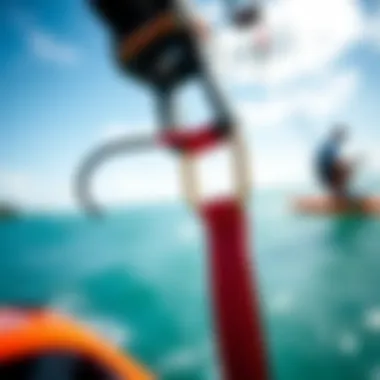
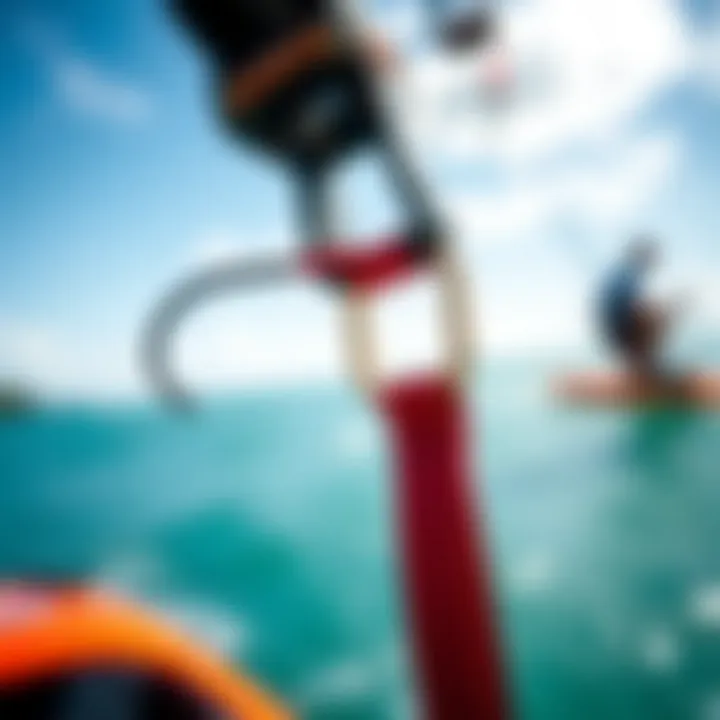
It's worth noting that the chosen attachment method should match a rider’s kitesurfing style. While some prefer the simplicity of a single clip, others may opt for an intricate daisy chain for versatility. Understanding these methods can significantly enhance riding experience and safety.
Release Systems
A robust release system is vital for the operation of safety leashes. This is often where the magic happens, allowing riders to disconnect from their kites in emergencies. Typically, these systems operate using one of three main types:
- Manual release: A lever or button is placed on the harness, which riders can reach to disengage the leash.
- Automatic release: This system activates based on too much tension or an out-of-control kite, letting the rider detach without needing to act manually.
- Dual-release systems: These combine the advantages of manual and automatic releases, offering flexibility in critical situations.
It's essential for every kitesurfer to familiarize themselves with their release system; after all, the ability to disengage quickly can be the difference between a troublesome fall and a safe landing. Some of the industry standards recommend practicing the release mechanism on land before hitting the water. This practice ensures familiarity, thereby reducing reaction time when situations become dire.
"In kitesurfing, knowing your safety leash's attachment and release systems is akin to a pilot understanding their aircraft’s controls. It can often be the thin line between adventure and mishap."
Best Practices for Using Safety Leashes
When it comes to kitesurfing, safety leashes are not just accessories; they are crucial safety devices that can mean the difference between a close call and a serious accident. Establishing best practices for using safety leashes is fundamental to optimize their effectiveness and ensure rider safety on the water. These best practices cover everything from pre-session checks to riding techniques, collectively aimed at minimizing risks associated with kitesurfing.
Pre-Session Checks
Before even stepping foot in the water, conducting thorough pre-session checks is imperative. These checks help identify potential issues that could compromise the safety leash’s functionality:
- Inspect Connections: Ensure that all connection points, including the hook and the wrist or harness attachment, are secure and show no signs of wear or damage. A loose connection can result in disconnection during critical moments.
- Check for Wear and Tear: Look over the leash for any fraying, cracking, or other signs of deterioration. Safety leashes, like any other piece of gear, have a lifespan. Don't take chances; replace them as needed.
- Test Release Mechanisms: If you’re using a leash with a quick-release system, practice the release function while still on dry land. This drill can save valuable seconds in an emergency.
Regular checks are your frontline defense in kitesurfing. Prevention is always better than a cure.
Proper Attachment Techniques
Correctly attaching your safety leash can drastically affect your safety while riding. The technique of attaching your safety leash to your harness or board might seem straightforward, yet there's more to it than meets the eye. Here are key points to remember:
- Use the Right Attachment Point: Make sure your leash connects to the designated point on the harness; using the wrong attachment can lead to malfunctions, particularly under stress.
- Secure Knots: If your safety leash involves any knots, ensure they are tied securely. A loose knot can unravel, leaving you with a detethered kite when you need it most.
- Avoid Crossed Lines: While attaching, ensure the leash isn’t tangled with other lines or gear. This can not only affect your performance but also compromise safety if entanglements happen while riding.
- Double Check Before Launching: Just before you begin riding, quickly verify that everything is securely attached. A swift glance can prevent mishaps before they begin.
Maintaining Control While Riding
Once you're on the water, maintaining control while kitesurfing is about more than just skill; it’s also about how effectively you manage the leash.
- Stay Aware of Your Surroundings: Be conscious of other riders, boats, and obstacles. A swift turn could put you in a precarious situation if your leash gets snagged or your kite takes an unexpected dive.
- Understand Kite Dynamics: The relationship between your kite and how it pulls can fluctuate. Ensure your safety leash handles unexpected pressure properly. Being ready to execute a quick release in case of a sudden pull or gust is a must.
- Practice Stance and Balance: A good riding posture will help maintain stability. Keeping your knees slightly bent and your core engaged can assist in absorbing shocks from waves or winds while giving you better control over your movements.
These best practices, though simple in concept, form the backbone of effective and safe kitesurfing with a safety leash. By embracing the ethos of preparation, correct usage, and ongoing awareness, riders can significantly enhance their safety experience on the waves.
Common Challenges with Safety Leashes
In the exhilarating environment of kitesurfing, safety leashes play a pivotal role in ensuring riders maintain control and safety while navigating through the waves. However, like any piece of safety equipment, they come with their own set of challenges. Understanding these challenges is vital for every kitesurfer, whether you're a seasoned pro or just dipping your toes into the sport. Here, we’ll explore two primary issues that riders face with safety leashes.
Entanglement Issues
Entanglement is perhaps one of the most daunting challenges related to safety leashes. When riders crash or face unexpectedly strong winds, the leash has a tendency to wrap around the kite or the rider themselves. This can lead to situations where the kite becomes uncontrollable, and the rider may find it difficult to detach from the setup.
- Impact of Entanglement: Besides the immediate risk of losing control, entanglement can lead to injury—both for the rider and nearby kitesurfers. A wrapped line can pull a rider down or lead the kite to jerk violently, creating a hazardous environment for everyone involved.
- Prevention Measures: To tackle this, practitioners can:
- Regularly inspect the leash to ensure there are no frayed areas that could worsen situations.
- Familiarize themselves with quick release systems, because knowing how to detach swiftly can save a bad day.
- Maintain a practice of navigating away from other riders when recovering from a fall, reducing collisions.
Leash Size and Length Considerations
Choosing the right size and length of a safety leash can have dramatic effects on the performance and safety of the rider. A leash that’s too short might restrict movement, making it difficult to maneuver in diverse water conditions. Conversely, a leash that’s excessively long can increase the risk of entanglement, particularly during tricky situations.
- Size Matters:
- Assessing Needs: Riders must consider their own riding style. For instance, if you favor acrobatic maneuvers, a slightly shorter leash might suit you, while wave riders may benefit from longer leashes.
- Short Leashes: Ideal for flat water and tricks, but can pose risks during jumps.
- Long Leashes: Suitable for wave kiting as they allow for more freedom but can tangle easily.
These considerations not only improve the overall kitesurfing experience but also contribute significantly to rider safety. Ensuring that you have the appropriate leash length tailored to personal preferences and conditions can be a game changer on the water.
Choosing the Right Safety Leash
Selecting the appropriate safety leash is not just a matter of preference. It's an essential decision that can significantly impact your kitesurfing experience. With various factors at play, from your individual riding style to the environmental conditions you'll face, understanding your options can help ensure that your time on the water is both safe and enjoyable. A poorly chosen leash can lead to complications, leaving riders in precarious situations when they least expect it.
Evaluating Your Riding Style
Riding style is a cornerstone of your decision-making. Whether you’re into freestyle tricks or cruising along waves, knowing how you ride can help narrow down your choices. Here are some crucial considerations:
- Skill Level: If you’re just starting out, a simple leash that gets the job done may suffice. Advanced riders often seek features that support more complex maneuvers.
- Type of Riding: Freestyle riders might benefit from a leash that allows for maximum mobility and minimal tangling, while those who prefer wave riding could opt for a leash designed to handle more extreme conditions.
Identifying your skill level and specific riding style can guide your choice of leash. Rookies should start with something user-friendly, while experienced riders could explore leashes with innovative features that enhance performance.
Assessing Environmental Conditions
Before you hit the waves, take a hard look at the conditions you’re facing. Wind strength, water conditions, and obstacles all play a role in your decision. Here’s what to think about:
- Wind Conditions: High winds may require a leash that offers a secure attachment without the risk of snapping in challenging conditions.
- Water Type: In surf-heavy areas, a leash with a buffer to prevent tangling may be beneficial, whereas flatwater conditions might allow for more flexibility in leash design.
- Obstacles: If you’re riding in areas with lots of rocks or debris, visibility becomes key. Choose a brightly colored leash, making it easier to see and reducing potential entanglement with surrounding hazards.
By thoroughly assessing these factors, you can choose a safety leash that not just fits your style but also adapts to varied conditions where you ride.
Choosing a safety leash shouldn't be an afterthought; it’s one of the most critical aspects of your kitesurfing arsenal.
Maintenance of Safety Leashes
When it comes to kitesurfing, the thrill of riding the waves is often accompanied by some underlying risks. That’s where safety leashes come in—they are not just additional gear but a lifeline that balances thrill with safety. However, like any other equipment, they require regular maintenance to ensure they continue to perform their job effectively. Neglecting leashes can lead to failures at critical moments, putting the rider and others at risk.
The maintenance of safety leashes involves various aspects, but primarily it focuses on regular inspections and cleaning techniques. These statements not only ensure the longevity of the leashes but also ultimately improve rider safety. Let's take a closer look at the essential components of this maintenance regimen.
Regular Inspections
Regular inspections are crucial for maintaining the integrity of safety leashes. Riders should take it upon themselves to examine their leashes before and after each session. Watch out for signs of wear and tear, such as fraying, cuts, or rust on metal components. Ensuring that the secure attachment points are intact is equally important as that’s your connection to both the kite and the water.
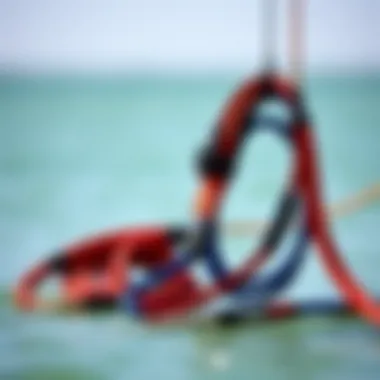
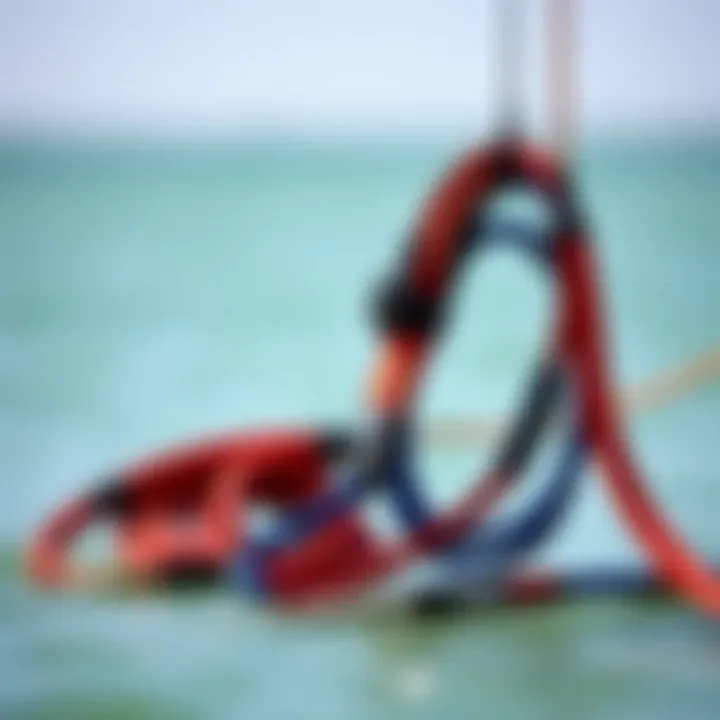
Consider the following elements during your inspection:
- Visual checks: Look for any obvious damage, such as frayed lines or loose stitching.
- Functional tests: Make sure the release mechanism works smoothly—practice operating it a few times to build muscle memory.
- Material concerns: Depending on where you ride, saltwater or UV exposure might degrade the materials over time.
Performing these assessments can prevent unexpected accidents when you’re out on the water. An inspection doesn’t have to take a long time, but it surely can save you a world of trouble.
"Just like a stitch in time saves nine, a thorough check can often save you from an unexpected plunge."
Cleaning and Drying Techniques
Equally as important as inspections, cleaning and drying are often overlooked steps in the maintenance of safety leashes. After every session, rinsing the leashes with fresh water is highly advisable. This simple act helps eliminate salt residues that can erode materials over time.
Here’s a quick guide on how to clean and dry your leash:
- Rinse in Fresh Water: Immediately after kitesurfing, run the leash under fresh water to remove any salt or sand.
- Gentle Scrubbing: If there is stubborn dirt, use a soft brush; this prevents damaging the material but helps in keeping it clean.
- Drying Properly: Hang the leash in a shaded area to avoid direct sunlight, which can warp materials. Make sure to spread it out rather than bunched up to facilitate even drying.
A well-maintained safety leash will not only perform better but also provide peace of mind while engaging in your exhilarating sport. Creating a routine around these maintenance tasks can save you both time and trouble.
For more information on maintaining equipment, you can visit Kitesurfing.com and delve deeper into maintenance tips that could benefit your entire setup.
Innovations in Safety Leash Design
In the ever-evolving landscape of kitesurfing, safety leashes have seen significant innovations that cater to the increasing demands for rider security and performance enhancement. As kitesurfing gains popularity, so does the need for reliable safety gear that can withstand various conditions and rider styles. The importance of these innovations cannot be overstated; they not only amplify safety but also boost rider confidence, allowing enthusiasts to focus on enjoying the sport instead of worrying about potential mishaps.
Technological Advances
Recent developments in technology have transformed the way safety leashes are designed and manufactured. Cutting-edge materials like Dyneema and Spectra are being used to construct leashes that are not only lightweight but also exceptionally strong, significantly reducing chances of breakage in critical moments. These materials provide a blend of durability and flexibility, ensuring that the safety leash adapts to the rider’s movements without compromising performance.
A notable technological feature is the integration of a quick release mechanism. These leashes come equipped with user-friendly systems that allow for rapid detachment from the kite in emergency situations. This capability is crucial, as it eliminates the time lag during which a rider could be at risk. Many riders swear by leashes with fail-safe mechanisms that engage quickly, creating a peace of mind that is hard to put a price on.
Additionally, some leashes are now designed with built-in swivels to prevent tangling, which is a frequent problem when riding in challenging conditions. Tangles can lead to uncontrollable kite movements, potentially endangering both the rider and others in the vicinity. Incorporating a reliable swivel mechanism into the design minimizes this risk, making it a valued innovation in the kitesurfing arena.
Future Trends in Kitesurfing Safety Gear
Looking towards the horizon, we can anticipate several trends that are likely to gain traction in the kitesurfing community regarding safety leashes. First, customization will become paramount. As riders seek personalized solutions that cater to their specific styles and preferences, brands will likely focus on offering tailored options, from color coded leashes to adjustable lengths suited for diverse wind conditions.
Moreover, we could expect advancements in smart technology integration within safety leashes. Imagine a leash that not only holds your kite but also monitors conditions through embedded sensors. These sensors might provide real-time data on stress levels, kite orientation, and even alert systems to warn riders of impending danger. While this technology is still on the drawing board, it signifies a movement toward a more data-driven approach to safety.
In sustainability terms, the push towards eco-friendly materials in safety gear is also becoming more prominent. Kitesurfers are more conscientious about their environmental footprint, leading to a demand for products made from recycled or sustainable materials. Brands that can balance performance with environmental responsibility are likely to seize a larger market share in the not-so-distant future.
"Innovation in safety gear is not just about technology; it's about empowering riders to push their limits while staying protected."
As the community evolves, the focus will shift from merely meeting safety standards to exceeding them, ensuring that every kitesurfer can relish the thrill of the sport with confidence.
Legal Considerations in Kitesurfing Safety
When it comes to kitesurfing, the thrill of the sport does not come without its own set of responsibilities, particularly legal ones. Engaging in such a dynamic water sport inherently involves risks, and understanding the various legal considerations is crucial. Riders, whether veteran or novice, must navigate these waters carefully to avoid potential pitfalls that can lead to serious consequences. Emphasizing awareness of regulations and ensuring adherence can protect individuals and foster a culture of safety.
Regulations and Guidelines
Various jurisdictions across the globe have implemented specific regulations and guidelines aimed at promoting safety in kitesurfing. These rules often stem from local environmental conditions, safety concerns, and the need to protect both participants and bystanders. Riders must familiarize themselves with these regulations as a top priority. For instance:
- Local Laws: It's essential to check the local laws governing kitesurfing in different regions. Some beaches have designated kitesurfing areas with specific guidelines regarding operating within those zones.
- Equipment Regulations: Certain regions may require specific safety gear, like safety leashes and life jackets, to ensure rider safety.
- Weather Conditions: Knowing the legal implications of ignoring weather-related advisories is important. Riding in adverse conditions could expose riders to legal liability if injuries occur.
- Permits and Liability: Some locations may require a permit to kitesurf. Not obtaining the necessary licenses can lead to fines or inability to recover costs in case of accidents.
Understanding these regulations not only enhances safety but also ensures riders are responsibly participating in kitesurfing activities, reducing the risk of accidents that could lead to legal issues.
Insurance Implications
Another critical aspect of kitesurfing is the availability of insurance. Many riders may not realize the complexities surrounding insurance when engaging in this sport. Without appropriate coverage, kitesurfers could find themselves in a precarious situation following an accident. Here're a few key points regarding insurance implications:
- Personal Liability: If an accident occurs due to a rider’s negligence, they may be held liable for any resulting injuries or damages. Liability insurance can provide coverage against these claims.
- Property Damage: Riders should also consider the potential for causing damage to property, be it personal or public. Insurance can help cover repair or replacement costs.
- Injury Coverage: Many policies can also cover medical expenses resulting from injuries sustained while kitesurfing. This can make a significant difference in recovery and financial stability after an accident.
- Peace of Mind: Having the right insurance guarantees peace of mind. Riders can focus on enjoying their sessions knowing they have protection in place.
In short, legal considerations in kitesurfing tie back to both regulations and insurance implications. Staying informed not only supports safer practices but also fosters a better kitesurfing community where riders look out for one another.
It’s important to think ahead. Keeping clear of legal troubles can save you from a world of headaches later. Always do your homework before hitting the waves.
Educational Resources for Safety Leashes
In the world of kitesurfing, knowledge is as crucial as the wind itself. Educational resources serve as guiding stars for both novice and seasoned kiteboarders, providing insights that can mean the difference between a smooth ride and a precarious situation. Knowing how to use safety leashes effectively, alongside the best practices, can significantly enhance rider safety and experience on the water. With a focus on manuals, guides, and training courses, these resources equip riders to navigate any challenge.
Manuals and Guides
Manuals and guides are the foundational stones of kitesurfing education. Think of them as your trusty roadmap amidst choppy waters. Most manufacturers, like Cabrinha and Naish, provide manuals with explicit instructions on how to assemble, maintain, and operate safety leashes. These documents are not merely pieces of paper; they contain invaluable insight into materials used, design features, and troubleshooting advice. Moreover, guides often include safety tips relevant to various riding conditions.
- Key Elements of Manuals and Guides:
- Assembly Instructions: Clear, step-by-step instructions help prevent mistakes.
- Safety Tips: Highlighting common issues, like entanglements, ensures you’re prepared.
- Care and Maintenance: Guidelines on cleaning and inspections keep your gear in top shape.
Being well-versed in your gear’s manual allows you to make informed choices, reducing risks while enhancing performance.
"Knowledge is power, and in kitesurfing, it's the power that keeps you safe."
In addition to manufacturer manuals, several reputable organizations publish guides focusing on kitesurfing safety standards. Websites like projectkite.com and kitesurfingforums.com offer extensive resources to deepen your understanding of safety leashes and their importance. Understanding these fundamentals sets the tone for responsible riding practices.
Training Courses and Workshops
While reading manuals is essential, nothing beats the hands-on experience gained from training courses and workshops. They allow participants to learn in real-time, under the guidance of experienced instructors. Courses cover everything from basic techniques to advanced maneuvers, often including sessions specifically on the use of safety leashes.
- Benefits of Training Courses:
- Practical Experience: Methodical training on correct leash attachment, adjustment, and emergency releases.
- Expert Guidance: Instructors can offer personal feedback and share tips based on their own experiences.
- Community Connection: Engaging with fellow riders fosters a sense of belonging and sharing of knowledge.

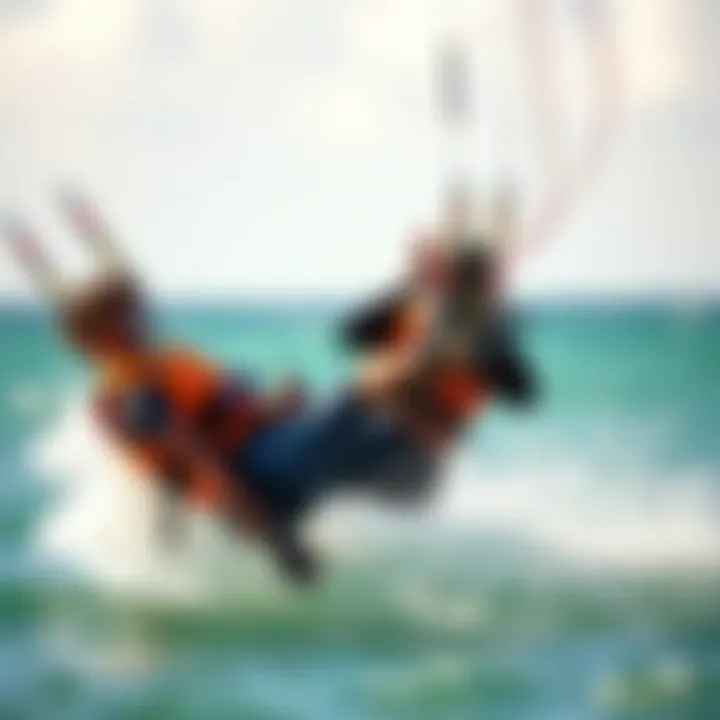
Many local kiteboarding schools, such as the Kite Academy and Kite Surfing School, offer practical workshops that encompass safety topics. Participating in these activities can make a profound difference in a rider's confidence and ability to make quick decisions in high-pressure situations.
By prioritizing educational resources, you not only hone your skills but also contribute to a culture of safety in the kitesurfing community. As your competence grows, so does your ability to enjoy the thrill of the waves, backed by the assurance that you've done your homework.
The Role of Community in Safety Practices
In the world of kitesurfing, community is more than just a collection of individuals; it is a vital forge that shapes safety practices and enhances overall rider experiences. Sharing knowledge, experiences, and skills in a collaborative manner enables riders to navigate the water's challenges with confidence. A well-informed community contributes significantly to the culture and standards surrounding safety gear. Through workshops, informal discussions, and the use of social media, kitesurfers can relay their insights, leading to enhanced safety practices for all.
The dynamic exchanges between riders foster an environment where safety isn't just a buzzword, but a lived reality. This communal approach fosters a deeper understanding of the risks associated with kitesurfing, allowing individuals to stay informed about best methods. As riders from varied backgrounds participate in discussions, they collectively build a reservoir of shared wisdom.
Sharing Experiences Among Riders
Firsthand accounts from fellow riders become invaluable sources of learning. When individuals recount their own kitesurfing adventures, they often include lessons learned from mishaps or near misses. These narratives can be eye-opening, allowing others to dodge the same pitfalls.
For instance, a rider might share how a particular type of safety leash malfunctioned during a turbulent session. This not only informs other kitesurfers about potential product weaknesses but also highlights the importance of pre-session checks, urging others to scrutinize their gear before hitting the waves.
- Encouragement through Shared Stories: When riders share their stories, they bring a level of comfort to beginners. Knowing that others have faced similar challenges can demystify the sport and create a sense of belonging.
- Learning from Mistakes: Every failure has a lesson. By cataloging their experiences, riders contribute to a collective learning process that amplifies overall awareness and caution within the community.
In forums such as Reddit, groups often spark conversations that can lead to enlightening practical tips. A post discussing equipment failures, for example, can branch off into multiple threads, each offering unique perspectives on preventive measures. The interaction transforms into an informal educational session that amplifies awareness and competency among kiteboarders.
Contributions from Kiteboarding Experts
Experts in kiteboarding serve as pillars in the community, guiding less experienced riders through their knowledge and insights. Their contributions often shine a light on aspects of safety that may be overlooked by everyday practitioners. These professionals possess not only a wealth of experience but also the capacity to distill complex information into digestible tips that anyone can implement.
For example, a seasoned instructor might advocate for specific safety leash designs suited to different weather conditions, elaborating on how each design functions under strain. This information is crucial, particularly for beginner kiteboarders who may feel overwhelmed by the plethora of available options.
- Workshops and Seminars: Many instructors offer workshops that focus on safety gear maintenance. These training sessions are a goldmine for developing essential skills while also understanding the rationale behind each safety component’s design.
- Online Resources: Websites and platforms like Facebook groups or professional kitesurfing sites also feature expert opinions. When these experts share their insights through articles or videos, riders gain specific, practical information, further solidifying community safety practices.
By leaning on the expertise of seasoned kiteboarders and engaging in community learning, kitesurfers create a protective net of knowledge that spreads beyond mere individual consciousness into a comprehensive safety culture that prioritizes collective well-being.
Assessing Safety Leash Performance
When it comes to kitesurfing, the safety leash is not merely an accessory; it serves as a vital lifeline. Assessing the performance of safety leashes is crucial in making sure they fulfill their intended role. By examining the effectiveness and the feedback surrounding these leashes, riders can better ensure their own safety while enjoying the thrill of riding the waves.
User Reviews and Feedback
One key aspect in gauging the performance of safety leashes is the feedback from users. Real-world experiences provide immeasurable insights that can’t always be gleaned from product descriptions or marketing jargon. Riders often share their thoughts on platforms like Reddit or specialized kitesurfing forums, where they detail their ups and downs with different leash models.
- Strength and Durability: Many users emphasize how crucial it is for a leash to withstand rough conditions. Comments often highlight specific leashes that have held up over time or conversely, those that failed under pressure.
- Comfort and Usability: Convenience is a big factor too. How easy is it to put on? Does it limit movement? User reviews can point to leashes designed with ergonomics in mind, making them more comfortable over long sessions.
- Emergency Effectiveness: Feedback often showcases instances where a leash performed its primary function during crises — helping users detach safely and quickly from their setup after a wipeout.
This kind of firsthand commentary helps others in the kitesurfing community to make informed decisions and encourages brands to continue innovating and improving their products.
Case Studies of Safety Failures
While safety leashes are designed to protect, there have been instances where they didn’t perform as expected. Analyzing these case studies uncovers critical lessons for riders and manufacturers alike.
One notable case occurred in a popular kitesurfing destination during a stormy day. A rider, eager to catch the wind, faced a violent gust that yanked them off their board, and their safety leash failed to detach as designed. The outcome was not only dangerous for the rider, who suffered an injury, but it also raised eyebrows regarding the leash's reliability in emergency situations.
This incident prompted an exploration into the leash's design and materials. Subsequent investigations revealed that some safety leashes failed to meet industry standards in terms of tensile strength. The results were alarming, but they served as a wake-up call for both riders and manufacturers to reevaluate the importance of rigorous testing and qualification processes.
Other lesser-known but equally instructive incidents emphasize the need for attention to leash maintenance. In another case, a rider used an aged leash that had frayed components and didn’t hold during a critical moment. Regular inspection and care can undoubtedly lengthen the lifespan and performance reliability of a leash.
In summary, assessing the performance of safety leashes hinges on understanding user feedback and drawing lessons from past failures. Each review is a piece of the puzzle, and every failure is an opportunity for improvement. By learning from both successful and troubled experiences, kitesurfers can make wiser choices that enhance their safety on the water.
"Your safety is only as good as the gear you trust. It's essential to listen, learn, and adjust accordingly."
This proactive evaluation plays a significant role in fostering a safer kitesurfing environment.
Comparison of Popular Safety Leashes
When it comes to kitesurfing, selecting the right safety leash can make or break your ride. The effectiveness of your safety leash hinges on various factors—materials, design, and how well they cater to the kind of conditions you'll encounter on the water. It’s not just about attaching your kite to yourself; it’s about making sure that your leash helps you regain control during unpredictable moments.
Understanding the differences between popular safety leashes is essential for riders of all skill levels. For instance, some leashes are designed specifically for freestyle maneuvers, while others emphasize safety during rugged surf conditions. By comparing them, one can gauge which is best suited for their unique kitesurfing environment and personal style.
Brand Analysis
One might think that all leashes are created equal, but that could not be further from the truth. Different brands bring their own flavor of technology and materials into the mix. Leading brands like Naish, Slingshot, and Cabrinha have various models that cater to the needs of different riders.
- Naish leashes often incorporate quick-release mechanisms that are well-suited for those who are new to the sport and may need to ditch the kite swiftly in tricky situations.
- Slingshot leashes tend to be favored by experienced riders for their durability in higher-stress conditions. They use high-grade materials that can withstand harsh pulls without compromising integrity.
- Cabrinha is known for its innovative designs, focusing on user comfort while ensuring robust performance, making them a hit with recreational kitesurfers.
In choosing a brand, it’s important to factor in not just price but the kind of riding you’ll be doing. Some brands might even offer additional features like reflective stitching or integrated storage for small essentials.
Performance Metrics
Evaluating performance metrics can be likened to checking the fuel efficiency of a car; you're trying to determine how a safety leash performs under pressure. Here are some key metrics to consider:
- Strength Test: Assessing the tensile strength of the leash is paramount. You want a leash that won’t snap under heavy load, especially during wipeouts.
- Flexibility: A leash should have enough flexibility to allow for some movement without being so loose that it could become a hazard.
- Release Speed: Quick release mechanisms should be easily accessible and responsive, allowing for a rapid disengagement when necessary.
- Weight: An overly heavy leash can be cumbersome while riding. Light leashes offer more freedom.
- Durability: Materials used—whether it's webbing or a lanyard—should be resistant to UV damage and ocean salt, as both can lead to deterioration over time.
So, when you choose a safety leash, consider not just its looks but these performance factors. They will determine how securely you can navigate challenging waters.
Culmination: The Essential Nature of Safety Leashes in Kitesurfing
Safety leashes are not just accessories in kitesurfing; they are lifelines that significantly enhance rider security amidst the thrill of wind and waves. Every time a rider takes to the water, they face a unique mix of elements and risks. In that realm of exhilaration, a safety leash emerges as an essential tool, bridging the gap between adventure and caution. Understanding its importance is fundamental to fostering a culture of safety in the sport.
Summary of Key Points
- Risk Mitigation: Safety leashes serve as a primary means of preventing accidents that could arise from sudden detachments of the kite or loss of control. Riders can focus on the experience, knowing they’re tethered to their equipment.
- Types and Functions: Different leashes, like standard and emergency quick releases, cater to various riding styles and situations. Familiarizing oneself with the types allows kiteboarders to choose what's best suited for their needs.
- Best Practices: Engaging in proper procedures before, during, and after sessions can maximize the efficacy of safety leashes while also reducing the chances of malfunctions in the heat of action.
- Community and Knowledge Sharing: The value of experience—both personal and communal—is crucial. Sharing anecdotes and lessons learned contributes to overall better practices in safety leash usage.
- Ongoing Maintenance: Regular checkups and proper cleaning extend the lifespan of a leash, ensuring that it performs reliably when it counts.
Final Thoughts on Safety Equipment
Safety leashes play a pivotal role in ensuring that kitesurfing remains a fun yet secure pursuit. The inherent risks of the sport necessitate a proactive approach toward safety gear. As kiteboarders, investing time and resources into understanding how to properly use and maintain their safety leashes can make a world of difference in potentially dangerous scenarios.
As the tides of innovation continue to shape kitesurfing gear, the fundamental need for safety must never be overlooked. Riders are encouraged to reflect on their riding practices and gear selections, ensuring that safety leashes are valued as an indispensable part of their equipment arsenal.
In the grand scheme of kiteboarding, it’s clear: safety leashes aren’t just recommendations; they are essentials.
"To ride safe is to ride smart; gear like your life depends on it, because in the thrill of kitesurfing, it indeed might."
For further reading on safety practices, visit Kiteboarding Safety.











